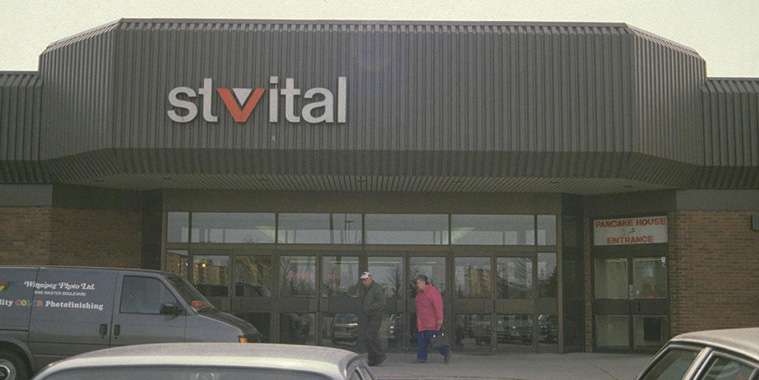By Christian Cassidy
St. Vital Centre is celebrating its fortieth year of operation, though plans for the shopping centre date back a further decade when officials of the T. Eaton Company set their sights on the Winnipeg suburb.
The population of the Rural Municipality of St. Vital grew rapidly in the 1950s and ’60s thanks to the addition of several residential subdivisions. It incorporated as a city in 1962 when it surpassed 27,000 people.
Retail giant Eaton’s took notice of this growth and in 1968 began amassing land in St. Vital for a new regional shopping centre. By 1974, it had attracted another retail partner, The Bay, and told the Winnipeg Free Press that they were ready to start development as soon as the city constructed the Fort Garry Bridge over the Red River to complete the four-lane Bishop Grandin Boulevard link between Fort Garry and St. Vital.
Work on the bridge got underway in 1976. It and Bishop Grandin Boulevard were officially opened in separate ceremonies in November 1978.
On October 25, 1978, Frederick S. Eaton of Toronto, president of Eaton’s, and George Richardson of Winnipeg, governor of the Hudson’s Bay Company, held a media conference at the Carleton Club to announce that construction of the $40 million “St. Vital Centre” would soon begin. Trizec Corporation of Toronto would own 50 per cent of the development while Eaton’s and The Bay each held a 25 per cent stake.
Trizec acted as the developer of the mall. It was already active in the city overseeing the construction of both the Unicity Fashion Square mall and the Winnipeg Square/Trizec Building at Portage and Main.
The design architect was Bergman and Hamann of Toronto with Terry Cristall and Gord McGarva of Winnipeg’s Number Ten Architectural Group acting as the supervising architects. The Bay hired local firm Smith Carter to design their store.
The total size of the site was 55,000 acres of which 630,000 square feet would become mall space. The four anchor tenants were Eaton’s, The Bay, Woolco and Safeway with most of the other 90 or so other stores also belonging to large chains such as Bata Shoes, Marks and Spencer, W H Smith, Thrifty’s and Winnipeg’s first Suzy Shier store.
There was a food court with eight “fast food stands”, including Caesar’s Palace, City Submarine, Yum Yum Tree and A & W. This was complimented by two sit-down restaurants in the mall and the restaurants offered in each of the department stores.
The main challenge for the architects was not to make shoppers feel as if they were walking down seemingly endless corridors as the mall stretched on for longer than two football fields at its widest point. This was achieved mainly through a central courtyard that is actually off-centre so that one cannot see from one end of the mall to the other.
The corridors themselves were broken up through the planting of seven fully grown ficus trees imported from Florida, numerous overhead skylights to change the lighting patterns, and carpeted seating areas to break up the monotony of the brown floor tiles. Individual retailers were also encouraged to build store fronts at their locations to give a “village feel” and to draw customers’ eyes to the side.
Much of the remainder of the 55-acre site was taken up by a 3,220-car parking lot featuring a ring road system and $135,000 in landscaping.
St. Vital Centre officially opened on October 17, 1979 under the watchful eye of its first general manager, Trizec’s Charles Finnbogason who had previously managed the company’s Chinook Mall in Calgary and Winnipeg’s Unicity Fashion Square.
There have been several renovations and expansions to the shopping centre over the years. The largest was the $30 million expansion that took place in 1997 – 1998 which reunited Finbogasson, still the general manager, with Sal Giacobbo, the site manager during its original construction.
The expansion increased the building’s size by some 20 per cent to make it 850,000 square feet. This allowed for 30 more stores, including a Chapters and Branigan’s Restaurant, and the addition of a Famous Players multi-screen cinema, which had been part of the plans since 1979, and a 500-seat “chalet-themed” food court.
Today, St. Vital Centre is owned by the Ontario Pension Board and contains 160 stores with a gross leasable area of 932,500 square feet, which includes space in the numerous stand-alone retailers located in its parking lot. While its sister development, Unicity Fashion Square, disappeared in 2000, St. Vital Centre has thrived and is Winnipeg’s second largest shopping centre behind Polo Park.
Christian writes about local history on his blogs, West End Dumplings and Winnipeg Downtown Places.



